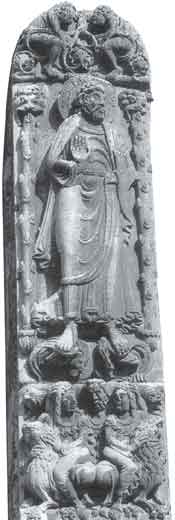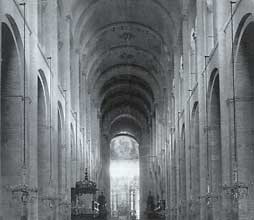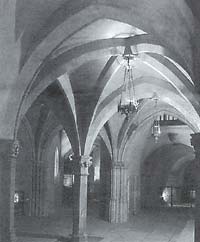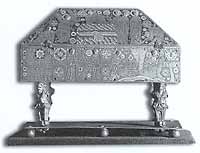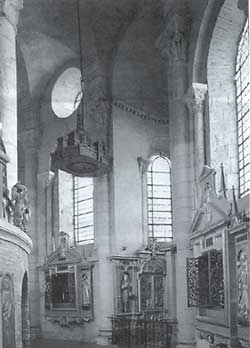Saint-Sernin
Dr. Marie-France Hilgar
| This magnificent Romanesque building was originally designed with the memory of Saturnin in mind. Saturnin was the first bishop and martyr of Toulouse and lived in the first half of the third century. His story is known to us through the Passio Sancti Saturnini, a text written in the beginning of the fifth century. |
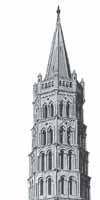 |
It tells how the holy man served a small church with two deacons and a priest. In 250 he was arrested in front of the Capitol, a major pagan temple. An edict published by Emperor Decius the very same year obliged all citizens of the Empire to make public sacrifices to the Roman gods, to prove their allegiance to traditional Roman practices. |
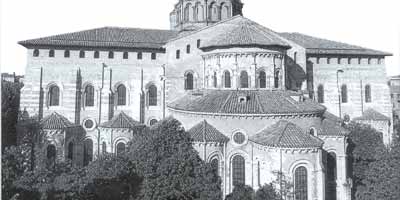 |
||
Saturnin heroically refused to apostatize. His feet were tied to the bull which was about to be immolated. The animal dragged the bishop's body at full speed, which was soon broken and lifeless. Two poor women had the courage to gather his remains and bury him in a wooden casket deep in the ground.
In the fourth century, Bishop Hilary, grateful for the merits of his predecessor, dug and found the tomb. Out of respect, he left the casket in its place, and had a small wooden basilica built over it. On account of rising attendance, Bishop Silvius had to enlarge the church at high cost towards the end of the fourth century, by which time devotion to the martyr was growing. Emperor Theodosius had declared Christianity the official religion of the State. The remains of the saint were solemnly transferred to the new building on November 1, 402. This basilica no longer exists and its exact size is uncertain.
A community of priests charged with the upkeep of the church is mentioned for the first time in a text of the year 844. In the middle of the 11th century the clergy was given control over their properties, and Saint-Sernin had enough money to replace the old basilica with the church we see today. The fame of Saint-Sernin was also helped by its status as a major stop for the pilgrims on their way to St. James of Compostella. A guidebook written around 1140 emphasizes the importance of Saint-Sernin. "It is necessary on the way (to St. James) to go and pray over the body of blessed St. Sernin, bishop and martyr....He was buried in a beautiful place near the city of Toulouse: a huge basilica was built there in his honor...his feast day is celebrated on November 29."
Work on the basilica was begun around 1070. By 1118 the building was well established but later progressed at a much slower pace. A few changes were made in the 14th century and later. Despite centuries of building and renovations, the finished church gives the impression of architectural unity.
A visit to Saint-Sernin starts outside where we can admire the harmonious layout of the building, where one's gaze is irresistibly drawn to the bell tower. Stone and brick, shade and light produce subtle contrasts. The eight-sided bell tower shows the different stages of its construction: round arches on the lower levels, "mitered" arches higher up. Its spire was added in 1478, carrying a terminal globe and a cross, bringing it up to a height of 65 meters (about 215 feet).
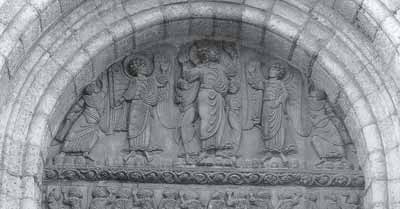
Door of Miegeville showing Christ's Ascension.
|
St. James the Greater. |
|
Double doors give access to the transept. On the south the famous "door of the Counts" and the door of Miegeville, thus named because it opened on the street which ran through the middle of the city (mieja vila), following pretty closely the old Roman road. The first door used to have three reliefs fitted in the corner stones. The center one, framed by two lions, has kept the inscription: sanctus Saturninus, which presumably represented the patron saint of the church. The other two reliefs probably showed his two deacons, Papoul and Honest, or his two successor bishops Silvius and Exuperius. Eight sculptured capitals refer to an iconographic display which contrasts damnation and salvation. Several vices (the lascivious man and woman, the miser) and the forces of evil (monsters attacking a man) match the parable of the rich man and poor Lazarus. The rich man is shown at his table with a servant to his right. Lazarus, already with a halo, receives pity only from dogs who lick his wounds. On the next capital, angels raise a mandorla, or sculptured emblem, of a small naked person symbolizing the soul of Lazarus. On the center pillar, an enigmatic scene: two people holding up the arms of a third person. These sculptures were completed before 1082. The second door is exceptionally topped by a sculptured tympanum, or relief under an arch, an early stage of design which would later become very fashionable. On each side are marble reliefs. The tympanum is devoted entirely to the theme of the Ascension of Our Lord, which is illustrated with an exceptional sense of composition and is thus rightfully considered a masterpiece of Romanesque sculpture. In the center, Christ, standing upright, raising His hands, His face turned toward heaven; two angels minister to Him while four others acclaim Him. On the lintel, twelve apostles, surprised and gesticulating, have their faces turned toward the disappearing Christ. At the sides, two angels remind them that Christ's Ascension is also the promise of Return to the eternal kingdom. The lintel is upheld by two admirable figures; on the left king David playing the lyre, on the right two enigmatic figures riding on the backs of lions. The columns are crowned by four capitals. The first one on the right is decorated with two lions with vines wrapped around them. The other three illustrate a common theme, that of original sin (expulsion of Adam and Eve from Paradise), as opposed to redemption through the coming of Our Lord into this world (Annunciation, Visitation, Massacre of the Holy Innocents). Two tall figures in the corners seem to stand guard at the door. On the right St. Peter gives a blessing with his right hand. He carries the keys of the kingdom of heaven on his belt and stands over Simon the Magician, a worker of false miracles, upheld by two demons. Peter is crowned by two angels, each elevating a host. On the other side, the apostle St. James the Greater marks by its iconography as well as by its style the artistic tie with the cathedral of St. James of Compostella, mentioned above. On the north side of the basilica, before the Revolution, stood a large cloister with marble columns and sculptured capitals.
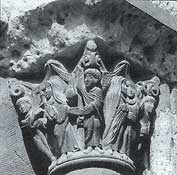 |
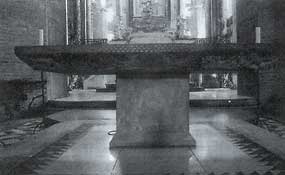 |
|
|
Capital showing the Annunciation and Visitation.
|
The altar consecrated in 1095 by Pope Urban II
|
The western side of the basilica shows also a double door adorned with eight capitals representing people and lions fighting or emerging from exuberant plants and vines. They belong to the "baroque" era of the romanesque style of the 12th century. This door was once richly ornamented. Legendary scenes associating St. Saturnin and St. Martial have disappeared. A few fragments are housed in the Museum of the Augustinians.
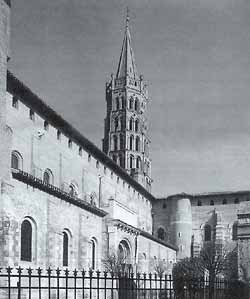 |
When walking inside Saint-Sernin, the visitor is overwhelmed by a vast array of light, which gives him a feeling of harmony and serenity. The interior of the church is richly adorned with more than two hundred and sixty Romanesque capitals. The main altar, consecrated by Pope Urban II, together with 14 bishops and archbishops, on May 24, 1096, stands above the crypt where lies the tomb of Saint Saturnin. This large altar is decorated on all four sides. On the front Our Lord is shown in a mandorla, or sculptured emblem, raised by angels who withdraw their gaze from the divine light, foreshadowing the return of the glorious Christ at the end of time. On the left side, Jesus, His hands outstretched to show His wounds, is surrounded by the Blessed Mother and Peter on the right, Paul and John on the left, accompanied by other apostles. On the right side of the altar are three other saints, and on the back of the altar, birds and a floral design. All around the altar an inscription bears the names of those patrons who showed their faith in the liturgy and placed their hope in the power of St. Sernin's intercession. The name of the artist, Bernard Guildin, is also inscribed.
The deambulatory, which circumscribes the sanctuary, should be visited in the morning when light flows through the windows. Half-way around the deambulatory, seven marble reliefs are cast in stone. The middle three form a homogenous group by their size and style. In the center, Christ in majesty in a mandorla, surrounded by the symbols of the four evangelists, is quite imposing despite the rather thin relief. On each side is a Cherubim and a Seraphim. The other four reliefs represent two apostles and two angels. All seven reliefs were completed around 1110. The deambulatory is impressive today more than ever because it offers an important array of retables, or figures over the altar, painted and gilded wooden reliquaries presented in each of the five side chapels as well as between each chapel. It is called the "tour of the holy remains" since it held a great many relics which the church was proud to possess. These were removed in the 19th century but put back in their rightful place in the 1970's.
|
(Top) The nave. (Right) Sanctuary with ceiling fresco of the Apocalypse and the symbols of the Evangelists. |
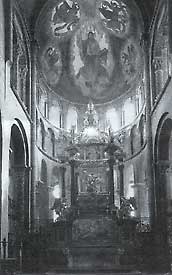 |
Ancient frescoes have been discovered on the western side of the north transept and restored. They give us an idea of how richly the church was decorated. The Resurrection fills the whole wall on five levels. On the lower level one can see the shields of two soldiers who were guarding Our Lord's tomb. On the second level the Holy Women meet the angel in front of the empty tomb. Higher yet, two prophets of the Old Testament venerate the risen Christ, in glory above them, presenting the Book and surrounded by the light emanating from stars and candelabras. On each side the alpha and omega remind us that Christ is the first principle and last end of all things. He is accompanied by the Virgin and Saint John the Baptist who recall His divine Sonship and His role of Redeemer. On the ceiling, the Lamb in the center of the mandorla, resplendent with colors, is held up by angels. Painted arches bring in complementary themes: 12 crowned virgins announcing the heavenly Jerusalem. All these elements of the Easter liturgy are treated with great vigor and perfect coherence. One can also notice scarcely visible vestiges of a large Crucifixion, with the two thieves on either side of Our Lord, a painting of St. Augustine and in one of the small chapels a large crucifix made of wood covered with layers of copper and adorned, at an earlier date, with precious stones.
Last but not least, towering over the sanctuary is a large, powerful and colorful painting of the triumphant Christ of the Apocalypse, surrounded by the symbols of the Four Evangelists, which was completed between 1536 and 1542.
|
|||||||||
No visit is complete without seeing the two crypts and their treasures, in particular a most stunning enamel reliquary of the True Cross, which was made in Limoges in the year 1200.
Dr. Marie-France Hilgar is a native of France, mother of four children, and assists at the Latin Mass at Our Lady of Victory Church, Las Vegas, NV. She is Distinguished Professor of French at the University of Nevada, Las Vegas and International President of the Foreign Language Honor Society. She specializes in 17th century history and has authored several books and more than 100 articles.
